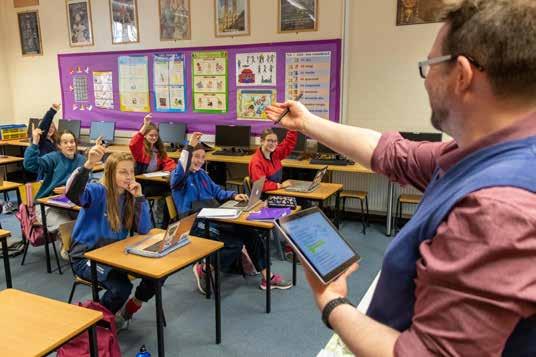
12 minute read
INNOVATION IN EDUCATION
PIVOT, PROGRAMME, PIANOFORTE - HOW ST GEORGE’S HAS EVOLVED ITS APPROACH TO TEACHING IN A PANDEMIC
St George’s is first and foremost a home of education. A place where opportunities unfold, discoveries are made, and passions ignited. In this environment, young women have been encouraged to enjoy and embrace learning, challenge themselves and strive to make positive change in whatever way they can. Education at St George’s has never been limited to academic studies, but neither was it ever limited by the more traditional approach to education for young women more common in the 19th Century when it was founded. A St George’s education has always been about striving for the best in everyone and finding something in their studies – be it academic, physical, artistic, dramatic, musical or practical – that they enjoyed and felt proud of. This sense of pride and accomplishment was always geared towards opportunities both while attending and beyond St George’s in whatever path was chosen. We have written in past editions about how education and teaching was interrupted when girls were evacuated to Hallrule House in 1940 during World War Two. That was clearly a terrifying time, but education and classes could still be run in a similar way, just in a different location, which managed to limit some disruption to the overall studies. COVID is not war time, and that is a comparison we cannot make, but the impact it has had on education and the innovation it has required from teachers and educationalists the world over has been like no other in modern times. It has required a complete shift in mindset, a commitment to creativity and a willingness to harness technology and all it can (and can’t) offer. In this edition, we wanted to share a snapshot into ‘lockdown school life’ and see how the staff and pupils have been adapting and responding to e-learning. The variety of activity and commitment to keeping classes engaging and inclusive has been remarkable. The ability to keep going, supporting pupils, teachers and each other has demonstrated resilience and creativity which is always encouraged right across the school. We hope you get a sense of how this has been undertaken and the great way the whole community of pupils, teachers and parents have pulled together.
TECHNOLOGY WITH ANDY LEASK
HEAD OF E-LEARNING
It is safe to say that, without technology, the transition to home working and supported home learning would have been significantly harder, if not impossible. Technology has changed the way many of us live our lives, and certainly has revolutionised industries, societies and economies the world over.
In Education settings it has been generating major changes over the past decades, creating enhanced learning and teaching opportunities. As Andy Leask said: “There were already a lot
of exciting, creative things happening with technology in school. Virtual and Augmented Reality tech was bringing learning alive for students and audio and video technology was being used by teachers to enhance learning and teaching, and by students to demonstrate their learning.”
The pupils had multiple opportunities to experience technology, and the pandemic undoubtedly accelerated the pace of mass technology adoption. This meant, according to Mr Leask: “in a very short space of
time we all (staff, students and parents) had to learn a lot. How to communicate with each other, remotely. How to teach remotely. How to assess remotely. How to look after the wellbeing of our students, our colleagues and ourselves. I feel proud of how positively everyone in the community embraced the changes, and learn a lot we did!”

Much of this learning has demonstrated new and creative ways to communicate, outside of the classroom. “Freed from
the constraints of a classroom, we saw and heard stories being told, principles demonstrated, theories tested and experiments conducted. Flipping the classroom – always an aspiration – became an absolute necessity, as we re-evaluated how to make the best use of the limited contact time we had with our classes.”

And the experience and positive results were felt across all year groups and stages, with older students gaining more control and responsibility for deadlines, assignments and calendars. While possibly
“not as much fun as dressing up as a pirate for Remove video lessons, but every bit as impactful as students and staff alike learned to manage workloads.”
When looking to the future, it is important to see what impact these learnings and experiences can have. Remote learning and these experiences is now a very real and potentially fixed part of the employment experience, so the skills of working and communicating remotely with video and project management software is essential, as well as multimedia resources to produce and consume content. Mr Leask recognises this positively: “We bear a
collective responsibility to support the development of numeracy and literacy in the young people we teach, just as much as we strive to build their digital literacy.”
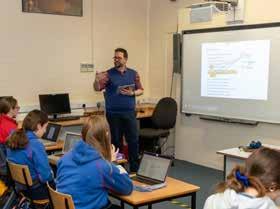
Technology provides an opportunity to empower educators and enhance the efficiency and efficacy of teaching. One clear example at St George’s has been the BYOD (Bring Your Own Device) policy in the Upper School. This has brought many practical benefits of technology for teachers and students with digital textbooks; audio feedback from teachers; accessing, producing, and sharing class notes; and collaborating with peers at a social distance!
There are leaps and bounds being made in technology, and it is important to balance this with the more traditional approach to education too. Mr Leask is very passionate about emphasising this: “While it’s
important we don’t turn our backs on tradition, we owe it to our students to embrace these changes and empower them to navigate the digital landscape that lies before them. It’s impossible to know exactly what the future will look like, but we’re excited to find out.”
PE DEPARTMENT - TAMAR DONNELLY
CURRICULUM LEADER OF CORE PE
Physical exercise, particularly in a school setting, so often involves team sport, groups of pupils working together in a team or challenging each other in competition. Putting that in a remote setting and having to make it work virtually is a huge leap (not necessarily of the sporting sort) and required much creativity to try and replicate.
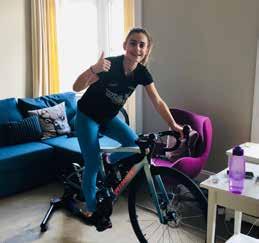
For the team at St George’s, it was a challenge, but one that they rose to, giving the pupils time away from screens and helping to support general health and wellbeing. Tamar Donnelly talked about some of the programmes they came up with: “We launched our School
Kilometre challenge at the beginning of term to encourage pupils and staff to get active outdoors and clock up as many kilometres as they could in the battle of the year groups versus staff. The girls were encouraged to use their PE or free time over lunch/break times to get outdoors and travel as many kilometres as possible through various means to add to their team total.”
There is nothing like a bit of competition for a St G’s girl and, when the ‘Race to Paris’ challenge was set up against Merchiston School in Edinburgh, there was a strong desire to the beat the boys. St George’s won this closely-fought race (“of course!” many of you might say.)
There have also been a number of online clubs including fitness, netball and hockey. But this has presented challenges as the social and team aspect of the subject was removed almost completely. The PE department looked to address this with various team, year group and house challenges for the girls to get involved in. For example: “In our
certificate classes, this might be giving them a ‘buddy’ to work with when carrying out an activity or training session. This has helped to keep them accountable and share training tips or call each other, for example, when going out for a run or whatever, which may help to increase their motivation. We have also used breakout rooms more for this and recently set an online dance project for our certificate classes to work together on, which they have really enjoyed.”

There have been positives from this, with girls trying new things they might not have had time to try before. Others have really invested time getting better at something, for example, running or even football freestyling. The girls have enjoyed learning new skills and setting targets to work towards over the course of a training programme. Mrs Donnelly notes how this has benefitted the pupils: “As
they have become more self-motivated to keep active without our or their peers’ encouragement every step of the way and that has taught the girls to take more ownership for their learning and to be more resilient.”
The PE Department has also been able to arrange online sessions with professional sportswomen, for example, from Scottish Hockey and Netball to share training tips and help to inspire the girls.
It hasn’t just been for pupils, however, as staff have been getting involved too, with greater emphasis on getting moving as much as possible during lockdown to help mental wellbeing as well as physical health. Staff involvement in our challenges has also been great as the department wants to inspire the whole school community to keep as active as possible in this period, when so much of our lives right now are in front of our screens. The emphasis on physical activity and the multitudinous benefits it brings has been significant across the UK during lockdown, from multiple nationwide and local challenges to the huge success of online fitness experts like Joe Wicks. The nation has been encouraged to move more. This is a very positive result of the pandemic and one that Mrs Donnelly hopes will continue: “Everyone has valued the
importance that physical activity and sport can have on their general health and wellbeing and encouraged new habits in lockdown. Perhaps [it has] inspired those to participate in more activities than before, when allowed to do so.”


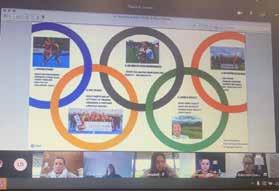

MUSIC - PETER THOMSON
HEAD OF FACULTY OF MUSIC
The joy, reverie and camaraderie that music at school, and beyond, can provide is well recognised across our communities. From choirs, bands and orchestras to theatre and individual lessons and performances, music comes in so many forms and is becoming more accessible to greater numbers. Music can be enjoyed alone and in groups but, in a school setting, beyond lessons it usually involves more than one person playing, singing, producing or creating. This has presented some challenges during lockdown as acknowledged by Peter Thomson. For him, the approach to supported home learning has meant: “adapting substantially to
provide a meaningful music education to our students. To meet our students’ needs, we have used resources which allow students to participate in home learning using their own devices. This enabled us to deliver an extensive and successful listening, aural and theory programme.”
Technology has been an excellent enabler for supporting lessons, but there are also of course limitations. For example, practical music-making was made more difficult and had limited options, but there were opportunities to engage such as:
“Young Musician and Young Singer competitions which proved to be a huge success with both students and
parents” through video creation, using Performer Platforms online. New course materials have been introduced during home learning to take the place of practical tasks, with new software enabling more participation in composition for U5-U6 pupils. This new approach to composition has “[encouraged]
teaching staff and pupils [with] the opportunity to investigate new methods of delivering and receiving the curriculum. For example, ensemble playing was seriously impacted, however, we managed to produce a programme which allowed some of our students (string players) to meet and make
music.” This type of innovation has been really welcomed but does present limitations. Singing is still not permitted in choirs but, through Teams, there can be some engaging in vocal work safely, which does allow voices to be used. The full return to group singing, as well as orchestras and ensembles, will be very welcome when allowed.
There have been lessons learned with many challenges faced, but Mr Thomson and his staff have been adamant to keep the offering available. He commented:
“Music is an integral part of a student’s education and finding ways of administering it in times of adversity can be challenging. Pupils have coped well and responded in a positive and constructive manner. Staff also have responded very positively, but I know that they can’t wait to return to practical music making as part of the curriculum or as an extra-curricular activity.
“Keeping an open mind certainly is an important ingredient, and not talking too much about getting back to ‘normal’. The use and importance of technology has certainly featured and will continue to do so not only here at school, but also in examinations, and that will be likely to remain in the future.”
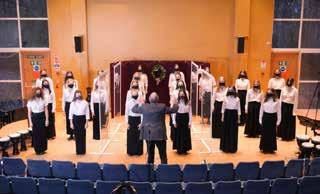
A PUPIL’S PERSPECTIVE
We are grateful to those pupils who study music and were happy to give an insight into their experience of supported home learning and how it has been achieved and even helped ease the stress and boredom of lockdown.
“During this period of supported home learning, my music teachers have helped me to refine my musical skills and improve my technique. I really look forward to my online music lessons every week, as it is a great way of relieving stress and finding comfort during a difficult time.”
Sive Lawrie, L6
“Sitting my ABRSM Grade 7 Violin exam remotely due to restrictions is going to be a challenging prospect considering the unfamiliarity of these exams being sat at home. However, having the time to practice and refine my musical skills has made this lockdown incredibly fruitful, and the joy and comfort that comes with playing music at home has definitely made these uncertain times more bearable for me!”
Maithili Vijayakumar, L6
“Music has given me the opportunity to step away from my computer and do something I cherish. Being at home has given me extra time to practise and refine my musical skills. My favourite part about doing music at St George’s is definitely playing in groups with people from varied year groups and it is certainly something I am missing. Music has significantly helped me with my mental health during this period, as it allows me to relax and unwind from the stress of these uncertain times”.
Fleur Drummond, U6
We would like to thank our teachers and pupils for sharing their experiences, innovations and learnings so willingly. Despite not being together physically, the level of interaction and collaboration has been marvellous and enabled that strength of community and companionship to continue.








